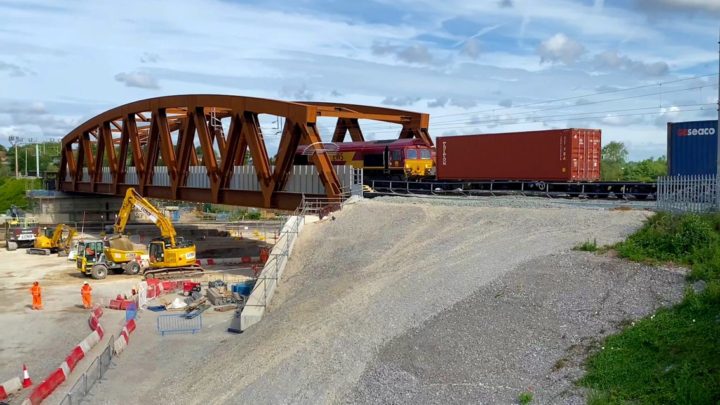
Tracks reopened this week on the Stechford to Aston freight line in Birmingham following the installation of a massive 2,600-tonne bridge built by Network Rail in partnership with HS2.
At 92 metres long, the steel and concrete structure becomes the longest single span railway bridge in the Midlands. It needs that clearance underneath so future tracks for Britain’s new zero-carbon railway can be built below for HS2 trains to access its Washwood Heath depot.
New zero-carbon railway
The demolition of the old railway viaduct and installation of the new bridge has closed this connection to Birmingham rail freight terminal for 23 days. But today the first train passed over the new structure, reopening the important rail freight route and marking a huge milestone for project contractor Skanska.
Patrick Cawley, director for On Network Works for Network Rail and HS2, said: “Seeing the first train pass over this iconic structure is a proud moment for the hundreds of people who’ve worked throughout the pandemic to make this new bridge a reality.
“It’s also a key part of the jigsaw to ensure the existing railway network works in harmony with HS2. I’m conscious this work has disrupted some passenger journeys over recent weeks and I’d like to thank CrossCountry customers for their patience while we carried out this major project.”
Rosario Barcena, Skanska Rail programme director, said: “Installing a railway bridge over an existing railway line is a complex engineering project that requires a huge amount of skill and dedication from all those involved. To have delivered this on time and despite of Covid-19 restrictions is a fantastic achievement and testament to the team involved.”
Reduced carbon emissions
Building and installing the bridge, known as SAS 13, involved precision planning and engineering and the use of some heavy-duty equipment.
Earlier this month the structure was driven into place by remote-controlled vehicles after being pre-assembled on site in a civil engineering project which has taken over two years. Building it on site reduced carbon emissions and cut the number of lorry movements on local roads, minimising impacts on the local community.
CrossCountry passengers are being given advanced notice of future work later in the summer on the same Birmingham New Street to Coleshill Parkway route.
Journeys will be impacted by more work to ready the railway for HS2 at weekends in August and early September.
Over four consecutive weekends from 13 August to 4 September, work will take place to:
- Upgrade railway signals at Washwood Heath.
- Install piles in preparation for a new underbridge at Duddeston.
- Engineering work on a bridge at Heartlands Park.
- Carry out maintenance activity on this section of railway to make it more reliable.
- To carry out the work safely, CrossCountry services between Birmingham New Street and Coleshill Parkway will be replaced with rail replacement buses.
- Some long-distance services will also be diverted which means journeys will take longer.
- Network Rail is working with CrossCountry to keep people informed.
